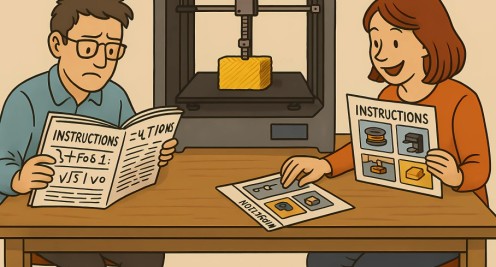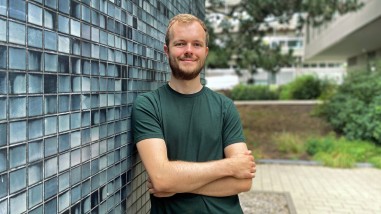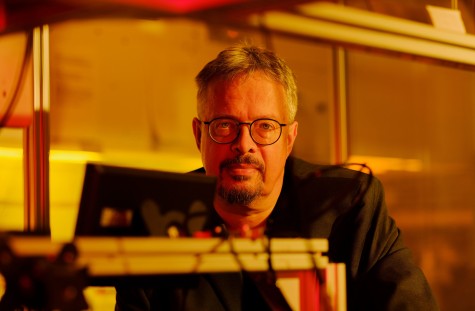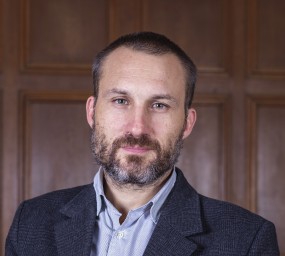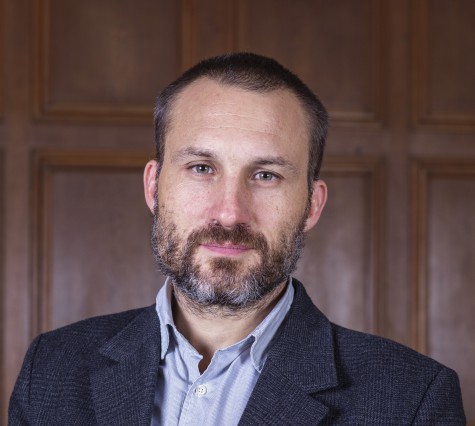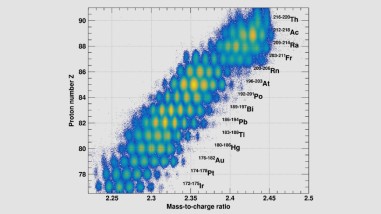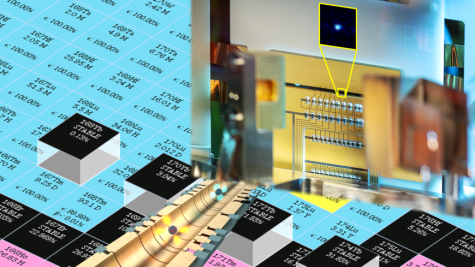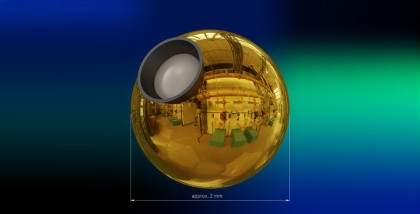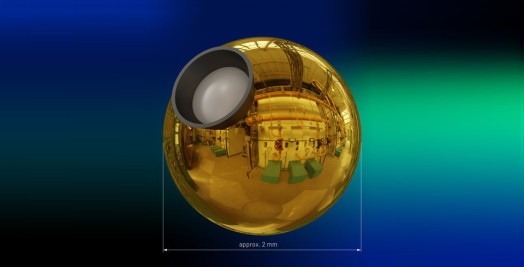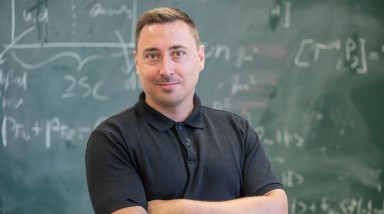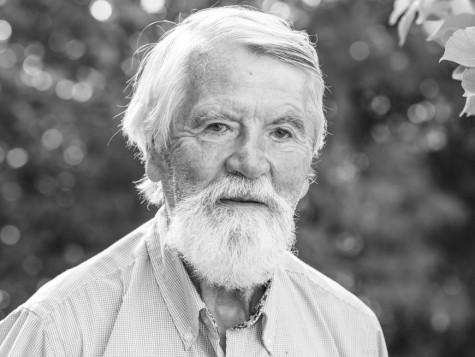Department of Physics
Nuclear & particle physics
News tagged with “Nuclear & particle physics”
-
![]() Bild: Physik | TU Darmstadt
Bild: Physik | TU Darmstadt![]() Bild: Physik | TU Darmstadt
Bild: Physik | TU DarmstadtImke Lopp | M.Sc. – Neu bei uns am Fachbereich im IKP | AG Nörtershäuser
2025/11/04
Wir haben ihr zum Start ein paar Fragen zu ihrem Forschungsgebiet und ihrer neuen Position als Doktorandin gestellt.
-
![]() Picture: ChatGPT/Timothy George Backert
Picture: ChatGPT/Timothy George Backert![]() Picture: ChatGPT/Timothy George Backert
Picture: ChatGPT/Timothy George BackertHow can a complex problem be simplified?
2025/07/24
TU researchers develop new method for a better understanding of quantum mechanical systems
A research team led by TU Darmstadt has transformed a difficult problem in quantum physics into a much simpler version through innovative reformulation – without losing any important information. The scientists have thus developed a new method for better understanding and predicting difficult quantum mechanical systems.
-
![]() Bild: Physik | TU Darmstadt
Bild: Physik | TU Darmstadt![]() Bild: Physik | TU Darmstadt
Bild: Physik | TU DarmstadtRico Holz | M.Sc.
2025/07/23
Neu bei uns am Fachbereich im IKP | AG Obertelli
Wir haben Rico Holz zum Start ein paar Fragen zu seinem Forschungsgebiet und seiner neuen Position als Doktorand gestellt.
-
![]()
![]()
Podcast mit Prof. Markus Roth
2025/07/15
„Heinermania – Der Podcast für Darmstadt“ hat in seiner aktuellen Folge Prof. Markus Roth zu Gast.
Markus Roth, gebürtiger Darmstädter, studierte in seiner Heimatstadt Physik und ist Professor für Laser- und Plasmaphysik am Institut für Kernphysik der TU Darmstadt.
-
![]()
![]()
The ‘strange’ side of atomic nuclei
2025/06/17
Professor Alexandre Obertelli receives ERC Advanced Grant worth €2.9 million
Unlike normal atomic nuclei, little is known about so-called hypernuclei, which belong to the category of ‘strange matter’. Prof. Alexandre Obertelli from the Institute for Nuclear Physics of TU Darmstadt wants to change that. His project, ‘When antimatter meets strangeness: a new era for precision hypernuclear physics’ (HYPER), is now being funded by the European Research Council (ERC) for five years with an Advanced Grant totalling €2.9 million.
-
![]() Picture: TU Darmstadt | Patrick Bal
Picture: TU Darmstadt | Patrick Bal![]() Picture: TU Darmstadt | Patrick Bal
Picture: TU Darmstadt | Patrick BalProfessor Thomas Nilsson becomes first “affiliate professor”
2025/06/16
TU Darmstadt honors renowned Swedish experimental physicist
On June 13, 2025, TU Darmstadt awarded the academic title of “Affiliate Professor” to an internationally renowned scientist for the first time. Professor Dr. Thomas Nilsson, professor at Chalmers University (Sweden) and Scientific Director of the GSI Helmholtz Center for Heavy Ion Research and FAIR GmbH, is now officially affiliated with the Department of Physics.
-
![]()
![]()
Nature-Veröffentlichung: Neue Erkenntnisse über Spaltung von exotischen Atomkernen
2025/05/13
In einem Experiment an der R3B (Reactions with Relativistic Radioactive Beams) Anlage am GSI Helmholtzzentrum für Schwerionenforschung ist es einem internationalen Forschungs-Team gelungen neue Erkenntnisse zur Spaltung von exotischen Atomkernen zu gewinnen.
-
![]() Picture: Mai, GSI/FAIR
Picture: Mai, GSI/FAIR![]() Picture: Mai, GSI/FAIR
Picture: Mai, GSI/FAIRPhysicists test quantum theory with atomic nuclei from a nuclear reaction
2025/04/28
Test of quantum electrodynamics circumvents insufficient knowledge of nuclear structure
Many atomic nuclei have a magnetic field, similar to that of the Earth. However, directly at the surface of a heavy nucleus such as lead or bismuth, it is trillions of times stronger than the Earth's field and more comparable to that of a neutron star. Whether we understand the behaviour of an electron in such strong fields is still an open question. A research team led by TU Darmstadt at the GSI Helmholtz Centre for Heavy Ion Research has now taken an important step towards clarifying this question. Their findings have been published in Nature Physics. The results confirm the theoretical predictions.
-
![]()
![]()
Prof. em. Achim Richter receives Lise Meitner Prize 2024
2025/03/03
-
![Schwenk_Yb-iso-shifts_high-res_Fig-1]() Picture: MPIK | PTB | Brookhaven National
Picture: MPIK | PTB | Brookhaven National![Schwenk_Yb-iso-shifts_high-res_Fig-1]() Picture: MPIK | PTB | Brookhaven National
Picture: MPIK | PTB | Brookhaven NationalNew insights into the structure of atomic nuclei
2025/02/13
In the search for “dark forces”, physicists came across deformed nuclei
When world-leading teams join forces, new findings are bound to be made. This is what happened when quantum physicists from the Physikalisch-Technische Bundesanstalt (PTB) and the Max Planck Institute for Nuclear Physics (MPIK) in Heidelberg combined atomic and nuclear physics with unprecedented accuracy using two different methods of measurement. Together with new calculations of the structure of atomic nuclei, theoretical physicists from the Technical University of Darmstadt and Leibniz University Hannover were able to show that measurements on the electron shell of an atom can provide information about the deformation of the atomic nucleus. At the same time, the precision measurements have set new limits regarding the strength of a potential dark force between neutrons and electrons. The results have been published in the current issue of the scientific journal “Physical Review Letters”.
-
![Experimentaufbau_High_Intensity_Gamma-ray_Source]() Bild: Dr. Udo Friman-Gayer
Bild: Dr. Udo Friman-Gayer![Experimentaufbau_High_Intensity_Gamma-ray_Source]() Bild: Dr. Udo Friman-Gayer
Bild: Dr. Udo Friman-GayerGrundlegende Schwingung in Atomkernen entschlüsselt
2025/02/10
TU-Forschungsteam gelingt präzise Bestimmung der Kernform
Wissenschaftler:innen der TU Darmstadt haben erstmals das komplexe Verhalten der sogenannten Dipol-Riesenresonanz in ungewöhnlich geformten Atomkernen detailliert untersucht. Die Ergebnisse der Arbeitsgruppe um Professor Norbert Pietralla am Institut für Kernphysik wurden kürzlich im renommierten Fachjournal „Physical Review Letters“ veröffentlicht.
-
![Bildgebung-Roentgenpulsen]() Bild: Stacy Huang / Adobe Stock Deeplab
Bild: Stacy Huang / Adobe Stock Deeplab![Bildgebung-Roentgenpulsen]() Bild: Stacy Huang / Adobe Stock Deeplab
Bild: Stacy Huang / Adobe Stock DeeplabMomentaufnahmen auf atomarer Ebene: Neue Bildgebung steigert die Sensitivität
2025/02/10
Mithilfe von Röntgenpulsen im Attosekunden-Bereich konnten Wissenschaftler*innen die Helligkeit und Auflösung von Aufnahmen ultraschneller Prozesse in ihrer natürlichen Umgebung erhöhen.
-
![Fusionstarget_2]() Bild: Focused Energy
Bild: Focused Energy![Fusionstarget_2]() Bild: Focused Energy
Bild: Focused EnergyBMBF fördert die Fusionsforschung an der TU Darmstadt
2025/02/03
Die Kernfusion gilt als vielversprechende Energiequelle der Zukunft.
Für die Forschung in diesem Bereich verfügt die TU Darmstadt seit langem über besondere Expertise. Das Bundesministerium für Bildung und Forschung (BMBF) fördert nun ein Verbundprojekt zur Untersuchung grundlegender Phänomene der lasergetriebenen Trägheitsfusion, an dem die TU beteiligt ist.
-
![]() Picture: Danielle Adams for TRIUMF
Picture: Danielle Adams for TRIUMF![]() Picture: Danielle Adams for TRIUMF
Picture: Danielle Adams for TRIUMFHow long did it take for our sun to form?
2024/11/14
Long-sought measurement to determine the timescale of the Sun’s birth
Have you ever wondered how long it took our Sun to form in its stellar nursery? An international collaboration of scientists is now closer to an answer. They succeeded in the measurement of the bound-state beta decay of fully-ionised thallium (205Tl81+) ions at the Experimental Storage Ring (ESR) of GSI/FAIR. This measurement has profound effects on the production of radioactive lead (205Pb) in asymptotic giant branch (AGB) stars and can be used to help determine the Sun’s formation time. The results have been published in the journal Nature.
-
![]() Picture: Klaus Mai
Picture: Klaus Mai![]() Picture: Klaus Mai
Picture: Klaus MaiImpressive insight behind the scenes of accelerator research
2024/10/02
Electron acceleration in Darmstadt celebrates its 60th anniversary
Where students of quantum physics usually work: Numerous visitors and invited guests took advantage of the 60th anniversary of the particle accelerator to take a look behind the scenes.
-
![]() Picture: Klaus Mai
Picture: Klaus Mai![]() Picture: Klaus Mai
Picture: Klaus MaiBreaking new ground in nuclear physics
2024/09/06
ERC Starting Grant for physicist Alexander Tichai
Alexander Tichai is receiving a Starting Grant from the European Research Council (ERC) for his project “DeformedNuclei – Ab initio pathway to deformed nuclei”. In the project the theoretical physicist is developing new methods for investigating deformed atomic nuclei and analysing the effects of interaction models on the predicted nuclear shapes. The funding totals 1.5 million euros.
-
![]() Picture: ESA
Picture: ESA![]() Picture: ESA
Picture: ESANew phase in neutron stars
2024/07/09
TU research team publication in renowned journal “Physical Review Letters”
Neutron stars are extreme objects whose inner matter can take on exotic forms. Researchers at TU Darmstadt and the University of Copenhagen have now been able to predict a new phase that favours “nuclear pasta”.
-
![]() Bild: privat
Bild: privat![]() Bild: privat
Bild: privatTrauer um Professor Peter Armbruster
2024/07/08
Mitentdecker der Darmstädter Elemente ist tot.
Professor Dr. Peter Armbruster war von 1971 bis 1996 leitender Wissenschaftler bei der Gesellschaft für Schwerionenforschung (GSI) in Darmstadt. Am 01. Februar 1985 wurde er zum Honorarprofessor am Fachbereich Physik der Technischen Hochschule Darmstadt ernannt.
-
![]() Picture: akromin/TU Darmstadt
Picture: akromin/TU Darmstadt![]() Picture: akromin/TU Darmstadt
Picture: akromin/TU DarmstadtUnderstanding the interior of atomic nuclei
2024/07/01
Publication by TU researchers in the renowned journal “Physical Review Letters”
Atomic nuclei can be tiny magnets. Their magnetic moment can be precisely measured, but the corresponding calculations have been deficient until now. Physicists from TU Darmstadt have now solved this problem, as they report in the journal “Physical Review Letters”.
-
![]() Picture: Hubble Heritage Team/Y. Chu et al/NASA
Picture: Hubble Heritage Team/Y. Chu et al/NASA![]() Picture: Hubble Heritage Team/Y. Chu et al/NASA
Picture: Hubble Heritage Team/Y. Chu et al/NASASynthesis of rare nuclei in the Universe
2024/05/13
Research team suggests new process
A new nucleosynthesis process denoted the νr-process has been suggested by scientists from GSI Helmholtzzentrum für Schwerionenforschung, Technische Universität Darmstadt, and the Max Planck Institute for Astrophysics. It operates when neutron-rich material is exposed to a high flux of neutrinos. The theoretical proposal, which was recently published in “Physical Review Letters”, may be the solution to a long-standing issue related to the production of a group of rare isotopes present in the solar system but whose origin is still poorly understood, the so-called p-nuclei.
Only the 20 most recent of 47 news items are displayed.




